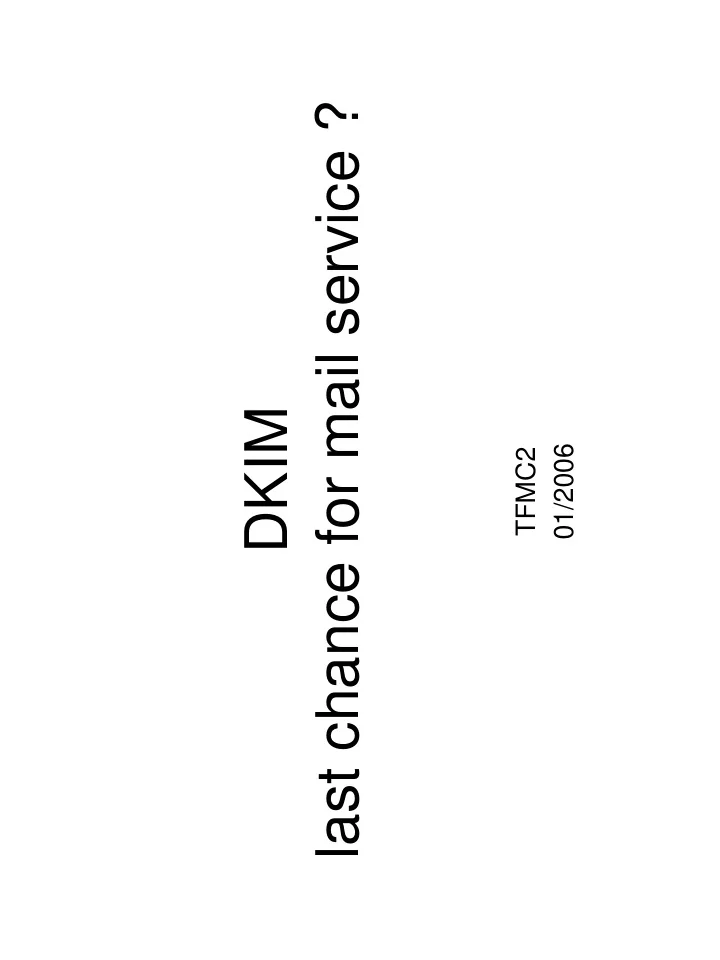

last chance for mail service ? DKIM TFMC2 01/2006
Mail service status • More and more spam, fishing, spoofing, virus • More and more energy in spam fighting • More and more messages lost because : – Imperfect automatic filtering – User error while removing spam – Delivery report unusable (too many return for spoofed email) • Trust in mail service is low now. 01/2006 2
Authentication • Authentication is not the ultimate solution but a pre-requisite to dissuade from many abuse. • PGP and S/MIME in a wide area are in defeat : – too complex for users – need to deploy private keys to end users – S/MIME : expensive PKI, sharing trusted CA model is only commercial, … 01/2006 3
Sender Policy Framework • A kind of « reverse MX ». • Do not authenticate message itself but the message server origin. • Altered by forwarders so require one of : – SRS (Sender Rewriting Scheme) srs0+yf09=Cw=orig.org=alice@forwarder.org – SMTP Responsible Submitter extension : MAIL FROM:<ann@orig.org> SIZE=1000 SUBMITTER=<bob@forwarder.org> 01/2006 4
DKIM • Signs message with asymmetric cryptography (similar to PGP and S/MIME) • Neither certificate authority nor “web of trust". Trust being based on the domain administrative delegation model. Public keys are published using DNS. • In most case messages are signed by the MSA : so private keys are stored by that MTA, no distribution to end user 01/2006 5
DKIM • Signs body and some headers • New header DKIM-Signature : • Public key stored in DNS – _domainkey subdomain –selector subdomain –DKK new RR type, fall back to TXT 01/2006 6
The signature algorithme Acces method Example to the public The signer key DKIM-Signature: a=rsa-sha1; q=dns; Canonicalization d=example.com; algorithm Length of body i=user@example.com; used for signature s=jun2005; c=nowsp; l=12345 t=1117574938; x=1118006938; Validity period h=from:to:subject:date; b=dzdVyOfAKCdLXdJOc9G2q8LoXSlEniSb Headers part of av+yuU4zGeeruD00lszZVoG4ZHRNiYzR the signature B64 encoded Query DNS for : signature value jun2005._domainkey.example.com 01/2006 7
Sender Signing Policy 1/2 • If a message contain a valid DKIM signature and if sender and signer are the same, the message is valid. • What happens else ? • SSP is a way for the sender to publish information so the signature verifier can decide if the message is suspicious or not 01/2006 8
SSP2/2 • Use DNS (DKP or TXT RR) • Result is one of – Some message of this entity may not be signed – Any message must be signed by the originator – Any message must be signed by originator or behalf a third party (mailing list, outsourcing,…) – Check individual level – Sender never signs message 01/2006 9
DKIM versus S/MIME • Not any expensive PKI deployment needed • Depend on DNS security • Not designed for end user to end user signature • No private key for end user • No change on existing MUA • Signature validation by one of the receiving MTA • Headers part of the signature • Sender Signing Policy C1 01/2006 10
Diapositive 10 C1 DKIM signature can't prove the signer agreement on content because private key is not under exclusive control of the signer. In fact S/MIME as real difficulties to be deployed. That's why some firms propose a virtual smart card key server to centralize keys and S/MIME verification proxy. In such configuration the S/MIME architecture is not so far from DKIM, isn't it ? CRU; 30/01/2006
DKIM threats analysis • Discussion about DKIM are huge because needs and implications concern all the Internet. • A lot of critics about DKIM along the mailing list archive • DKIM threats is a draft that summarize it : http://www.ietf.org/internet-drafts/draft- fenton-dkim-threats-02.txt 01/2006 11
Some identified limits • DNS pollution • Exploit body length limit • Canonicalization abuse • Use of revoked key • Signed message replay • DOS attack against DNS or signer verifier • Compromise of MTA signing server • Look-alike domain names (O/0 l/1, ….) • Short time domain names 01/2006 12
DKIM and ML • Still an open discussion because no RFC specifies what’s a ML. – Some says a MLM is forwarder – Some says a MLM is a remailer • A forwarder must just preserve existing signature • Forwarder is simple but may ease replay attacks and don’t solve the question of “ML reputation”. • A remailer may remove existing signature and apply its own one. • DKIM in a remailer is very complex 01/2006 13
Message service architecture • Signature added by the MSA require any mail received to be authenticated first. • SMTP-AUTH (port 587) should be used for roaming and non roaming users. • It make logs more valuable • It can block botnet/Virus • Must not block outgoing access to port 587 (is this specified in eduroam ?) • Internet draft : Email Submission: Access and Accountability 01/2006 14 http://mipassoc.org/spamops/draft-hutzler-spamops-05.txt
Mail service architecture and DKIM script script Add DKIM Add DKIM signature signature MSA MSA (no auth,) (no auth,) Output Output MTA MSA MTA MSA UA UA (port 587) (port 587) Signature Signature UA and SSP UA and SSP check check SMTP SMTP auth auth Filtering Filtering MX MX service service SMTP SMTP 01/2006 15 auth auth
packages • Opensource : – libdkim W32 from ALT-N – Dkim-milter from sendmail – Dkimproxy from Jason Long • Commercial – Mdaemon ALT-N – powerMta port 25 – Strongmail strongmail 01/2006 16
17 Question ? 01/2006
Recommend
More recommend